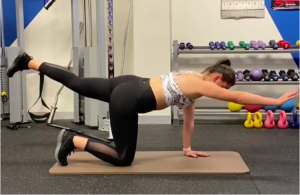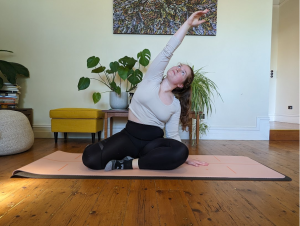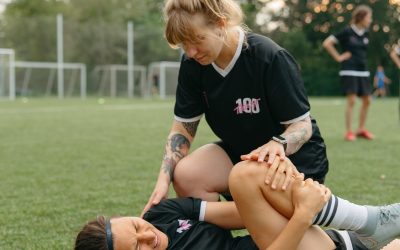Pilates – what’s it actually all about?
I know you see the word Pilates and have terrifying images of hot pants and shouty instructors and backbends that rival the exorcist. I’m here to inform and hopefully make you less fearful of gentle rehabilitative exercises.
What is Pilates?
Pilates is a combination of strengthening and stretching based exercises often using body weight and repetition. The exercises are based on some core founding principles:
- Centre
- Concentrate
- Control
- Precision
- Breathing
- Flow
These principles give Pilates a focus on symmetry and rhythm. It also gives you what FEELS like a thousand things to think about while you’re doing what LOOKS like a very simple movement. Generally with Pilates, the goal is to make the quite difficult look effortless. It challenges balance, strength and flexibility, while integrating posture, the pelvic floor and diaphragm to become a whole body exercise.
Why is it called Pilates?
The practice started with a man named Joseph Pilates who had a background of gymnastics, bodybuilding, wrestling, and dance. During WW1 he was imprisoned for being German by the British. There he began to rehabilitate his fellow German prisoners with exercises using body weight and springs from the beds. He and his wife later opened a studio in New York to teach what was originally called “contrology”. It caught on quickly with local ballet dancers, the two practices sharing similarities with movement and discipline, and the name Pilates stuck.
What’s the difference between Mat Pilates and Reformer Pilates?
Mat Pilates uses body weight and the ground as the primary equipment. This makes it easier to perform at home or travelling. It’s performed on a mat to give a little cushioning and grip for your body on the floor. The main resistance comes from gravity and your body weight, as well as resistance bands where needed.

Reformer Pilates uses a bed with springs and pulleys to perform different movements. This allows for exercises that can be lighter than your own body weight which can increase/decrease the challenge depending on the exercise. It’s best done with someone to literally show you the ropes since the anatomy of a reformer can feel like a new language. I always recommend a smaller class if you’re having your first go.

What is Clinical Pilates?
Clinical Pilates is the marriage of Pilates with exercise rehabilitation. Allied health care practitioners use their training in biomechanics and understanding of how pain works to inform a session of Clinical Pilates. It works best for patients with chronic pain (longer than 12 weeks) and those with joint instability and hypermobility. It can also be a great stepping stone into regular Pilates classes for anyone hesitant about exercise after having pain or injury. These sessions are often performed in one-on-one sessions or small groups to keep focus on you and your progress.
I heard Jackie is offering Clinical Pilates at Ferguson Street Osteopathy?
You would be correct! I’m obsessed with movement and (obviously) a nerd for Pilates. My Osteopathy sessions often end in some Pilates-based rehab exercises and my Clinical Pilates sessions often have one or two hands-on manual therapy techniques before getting started. It’s a Mat Pilates session designed to help you reach your functional goals and help manage your pain.
How often should I practice Pilates?
More frequent Pilates helps your body to adapt and progress. I practice at home around 3-4 times a week for maybe 30 minutes. During the pandemic I had time to get a lunchtime session in daily but we’ve moved on from those days. For a Clinical Pilates class I like to see someone weekly until the movements look easy and then space face-to-face sessions out while getting them to practice at home.
If you’re looking for exercises for chronic pain or just want some guidance for how to get into Pilates, please come chat with me.
Fun FAQs:
Pilates is so expensive.
Not a question, just a fact. Reformers are expensive equipment to acquire and maintain. Clinical Pilates includes curated rehabilitation with the expertise of an allied health-care professional. Moving your body on the floor is free. Take home what you learn in your classes is my advice.
How is it different from yoga?
Yoga and Pilates have completely different origins and I won’t go into the entire history of yoga (have fun down that google rabbit hole). Yoga tends to include lots of sustained postures and positions whereas Pilates includes more repetitive movements.
Yoga and Pilates often get a little bit combined and blended in practice, both having a focus on moving with mindfulness. Joseph Pilates also studied yoga on top of every other thing available to him in the 1910s apparently, so Pilates has been influenced by yoga.
Will it hurt afterwards? If it hurts does it mean I’m doing it wrong?
Pain during practice is not ideal but not unheard of. You shouldn’t get pain on the first rep of an exercise, if so it’s probably not the right one for your body that day. If you feel burning achy pains during a set, it’s most likely your newly woken up muscles fatiguing. That will increase lactic acid in the muscles which post-exercise can make you feel stiff and sore, and that can last for 1-2 days. In Clinical Pilates, because the purpose is to rehabilitate chronic pain, many of the exercises won’t feel painful, they’ll actually feel relieving.
Is it a cult?
I mean… if it’s not hurting other people, I think not.
Some studies on Clinical Pilates:
- Effects of clinical pilates exercises in patients with chronic nonspecific neck pain: a randomized clinical trial
- Effects of Pilates Exercise Programs in People With Chronic Low Back Pain – PMC
- Effects of pilates on patients with chronic non-specific low back pain: a systematic review – PMC
- Effects of clinical Pilates exercises in individuals with fibromyalgia: A randomized controlled trial – PMC

Happy moving 🙂




